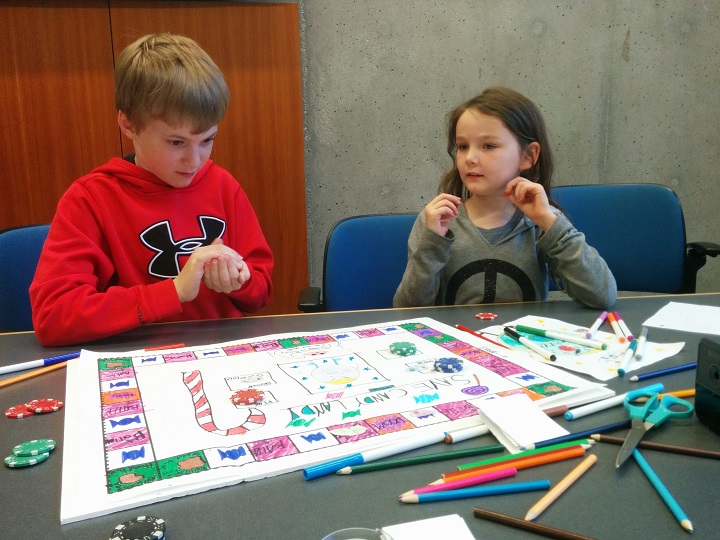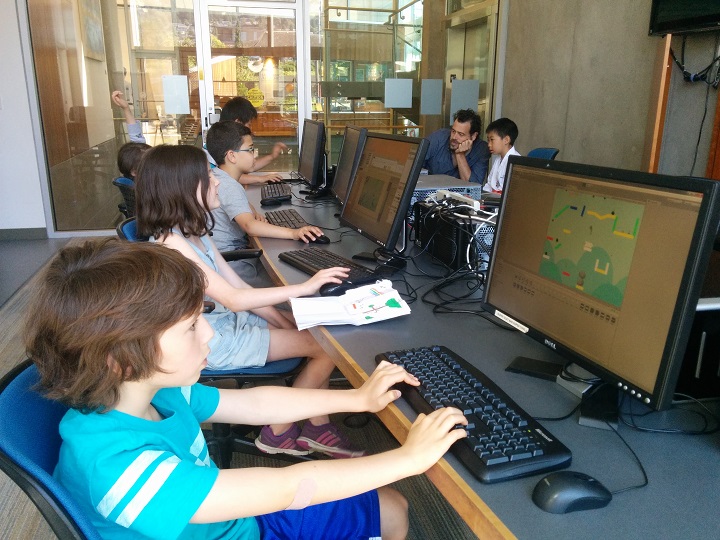Whether parents like it or not, games are a part of kids’ lives but two veterans of film and video game production are hoping to leverage that passion into a new learning opportunity.

Jean Mistrot and Daniel Roizman’s UME Academy infuses educational content with play using Inquiry-Based (IB) learning.
Unlike traditional learning practices that simply present established facts or a smooth path to knowledge, IB learning starts by posing questions, problems or scenarios, which causes students (with the help of facilitators or teachers) to identify and research issues to develop their knowledge or come to a solution.
Play happens everywhere so why shouldn’t learning?
“Games are part of the kids’ lives. Regulating how much time they play is on you as a parent,” says Roizman, who through his two young boys at home saw firsthand how today’s learners are able to understand and adopt technology faster than ever before.
“What we’re doing is we’re making it educational and helping kids become creative thinkers. So instead of having the kids being the consumer of content, we’re helping them become the creators of the content that they love. We’re turning it into a learning opportunity.”
Roizman sees this approach as filling a critical gap of learning, especially in elementary schools. Their programs are aimed at kids aged six to 13.
“There was something missing… where, yes, they have lots of access to knowledge but frankly, kids have had access to libraries forever. And yet, it’s not really until university where they are independent and become self-directed,” he said
“They touch on parts of that in school, but it’s not really from design-thinking. What I’ve noticed is kids are still lacking the structure of the design process. So when they’re asked to create something, they’re still overwhelmed.”
Instead of saying to the kids ‘what’s your big idea’, Roizman and Mistrot start with breaking down the steps and iterating on it.
UME Academy has been running since spring 2015. The creative pair started off by providing classes in the West Vancouver Community Centre before eventually offering their programs in four schools in North Vancouver and Burnaby Edmonds Community Centre a year later. The academy was not part of these schools’s curriculum, instead the program is offered before and after regular scheduled classes.
Ironically, UME Academy appears to have started up at a good time. The B.C. government announced in late 2015 that it was kicking off a three-year transition to a new curriculum in schools across the province this September.
Starting with students in kindergarten to Grade 9, they will continue to learn the basics like reading, writing and arithmetic, but the new provincial curriculum will also focus on collaboration, critical thinking and communication skills to better prepare them for college, university and the work force.
How creating video games provides a perfect teaching tool
The beauty of video games, Roizman says, is there’s room for every child to be a part of the process and everyone has a role in the game.
“We haven’t seen any kids failing. They all seem to know enough that they can create and play with, and others can play and have fun,” he said.
Sure there’s computer and screen time involved, but surprisingly it’s only for the first four or five classes. After that, there are no computers. Instead Roizman and Mistrot teach the students the design process on a huge sheet of paper.
“They design the blueprints for a level, they may do one or two more levels and then we walk around and look at other games. And we teach how to give feedback and ask questions,” Roizman explained.
What do parents have to say?
For Karmyn Turner, putting her video game obsessed eight-year-old son, Holden, in UME Academy took a leap of faith.
“I am constantly having an internal battle with the appropriate amount of time on the screen,” Turner said.
“He pretty much begged us to take this. It took me a while to come around to letting him do it. I was already struggling with how much time he gets to play video games. I think it’s too much and he thinks it’s not enough.”
But after seeing the benefits of the program, Turner is happy she finally came around to enrolling Holden.
“It’s taught him it’s not just about video games,” she said.
“One of the things I liked is they teach them critical thinking. They have to figure out. They can’t just have a zombie game and it magically appears, he has to figure it out – what are the zombies doing? What’s the next hurdle? And they make them actually map out their game before they can actually start coding the game.”
Holden has been taking the class since last September and Turner said she’s noticed small subtle changes in him.
“One of the first classes he went to he said, ‘I understand why you have rules now. I always just thought they were just random decrees by teachers and parents but I understand they create order and structure and they’re there for boundaries'”, Turner said.
“My mouth fell open when I heard him say that.”
And she says it’s funny that most of his other programs he’ll happily miss but he never misses a video game class.
“I love that we can give him these skills at an early age that he can continue to develop as he gets older through video design or school work,” Turner said.
“It’s an important skill to have and many adults don’t have it. So I think if we can give this to our kids at an early age then we’re setting them up for great things and this is a completely unexpected benefit.”
For Megan Black, the academy provided exactly what she was looking for as a program for her nine-year-old son Levi, who is gifted in visual spatial and falls on the high-functioning end of the autism spectrum disorder.
“I’ve been trying to find things for him because he has learning disabilities in other areas,” Black said. “We wanted to find something he could thrive in.”
Black says Levi loves to read but also has a creative streak and by giving him an opportunity like UME Academy it allows his brain to develop in ways that work for him.
“This will help him survive in life, in general,” she said.
“That’s why we love this for him because this is the way his brain works best and it’s giving him tools that we can’t help him with.”
Not just about playing video games
Black and Turner echo Roizman’s belief that their programs are more substantive and that it’s not just about playing video games.
“There’s the whole STEM academic discipline behind it — Science, Technology, Engineering and Math. We inject that in,” he said.
“Kids don’t know it, but when we talk about gravity and mass and friction…. we say watch when your character pushes the boulder. What if you change the mass of the boulder? Kids laugh and have fun. The boulder is as light as a feather or the boulder crushes them. They’re learning all of those concepts at a very young age.”
Next up for UME Academy, Roizman says, is getting a pilot into schools to actually integrate with the classrooms. Ideally they’d like to work with the new B.C. curriculum that’s being rolled out this fall.
The natural fit would be in science. Ideally Roizman and Mistrot would like to be embedded in a class versus carving out a separate topic in the school day, since teachers are limited in the time they have to teach.
“We’d like to take one grade and take one module, like science, and enhance it with game-design,” Roizman said.
“So while they’re teaching about Mars, the planets, and the solar system, the teacher will do that component. We’ll then spend the time with students to create games out of that. The students would be able to take what they’re learning from the teacher and apply it to a game.”
He gives the examples of kids looking at how they would launch a rocket or create a game out of tracking resources like food and oxygen.
For more information on UME Academy’s programs and camps, click HERE.






Comments